| Listing 1 - 10 of 13 | << page >> |
Sort by
|
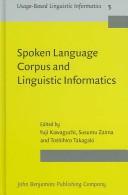
ISBN: 1282154885 9786612154881 9027292760 9789027292766 9781282154889 9027233179 9789027233172 6612154888 Year: 2006 Publisher: Amsterdam Philadelphia J. Benjamins Pub. Co.
Abstract | Keywords | Export | Availability | Bookmark
 Loading...
Loading...Choose an application
- Reference Manager
- EndNote
- RefWorks (Direct export to RefWorks)
Linguistic Informatics is a research field named by the Center of Excellence (COE) Program: Usage-Based Linguistic Informatics (UBLI), which aims to systematically integrate studies in computer science, linguistics, and language education. The first part of this volume contains three lectures on spoken language analysis and corpus linguistics delivered at the Second International Conference on Linguistic Informatics held on December 10, 2005. The nine contributions in the second part come from the Collaboration Workshop on spoken language corpora between UBLI and C-ORAL-ROM, a consortium researching the spoken Romance languages. In the third part, four studies representative of Linguistic Informatics are presented. These studies deal with (1) Corpus-based analysis of linguistic usages, (2) Typological study of different languages, (3) Effective integration of e-learning and task-based face-to-face teaching and (4) Fosterage of language education researchers with expertise in the field of Linguistic Informatics.
Colloquial language --- Language and languages --- Colloquialisms --- Conversational language --- Speech --- Data processing --- Variation
Book
ISBN: 9027261539 9789027261533 9789027204974 9027204977 Year: 2020 Publisher: Amsterdam John Benjamins Publishing Company
Abstract | Keywords | Export | Availability | Bookmark
 Loading...
Loading...Choose an application
- Reference Manager
- EndNote
- RefWorks (Direct export to RefWorks)
"What is the best way to analyze spontaneous spoken language? In their search for the basic units of spoken language the authors of this volume opt for a corpus-driven approach. They share a strong conviction that prosodic structure is essential for the study of spoken discourse and each bring their own theoretical and practical experience to the table. In the first part of the book they segment spoken material from a range of different languages (Russian, Hebrew, Central Pomo (an indigenous language from California), French, Japanese, Italian, and Brazilian Portuguese). In the second part of the book each author analyzes the same two spoken English samples, but looking at them from different perspectives, using different methods of analysis as reflected in their respective analyses in Part I. This approach allows for common tendencies of segmentation to emerge, both prosodic and segmental".
Colloquial language --- Colloquialisms --- Conversational language --- Language and languages --- Speech --- Phonetics --- Grammar --- Pragmatics --- Comparative linguistics --- Colloquial language.
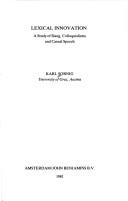
ISBN: 9027225184 9786613359698 1283359693 9027280800 9789027225184 9789027280800 Year: 1981 Volume: 2/5 Publisher: Amsterdam Benjamins
Abstract | Keywords | Export | Availability | Bookmark
 Loading...
Loading...Choose an application
- Reference Manager
- EndNote
- RefWorks (Direct export to RefWorks)
In addition to borrowing from various foreign sources, the main origins of slang terms are the activation and revitalization of existing morphological and lexical material. Metaphorical manipulation of lexical items, as the main device used for the production of slangisms, shows remarkable similarities in languages otherwise quite different from each other. Slang is analyzed as a kind of substandard language variation which any full-fledged language is bound to develop because it is experimental in that it is born from insubordination and protest against the stress experienced in the speech co
Colloquial language. --- Slang. --- Slang --- Colloquial language --- Lexicology. Semantics --- Sociolinguistics --- Dialectology --- Argot --- Cant --- Obscene words --- Colloquialisms --- Conversational language --- Language and languages --- Speech --- English language Slang --- English language
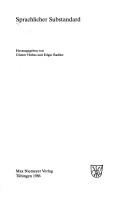
ISSN: 03446735 ISBN: 3484220368 3110935880 3484220449 3484220457 Year: 1986 Volume: 36 Publisher: Tübingen
Abstract | Keywords | Export | Availability | Bookmark
 Loading...
Loading...Choose an application
- Reference Manager
- EndNote
- RefWorks (Direct export to RefWorks)
Keine ausführliche Beschreibung für "Sprachlicher Substandard I" verfügbar.
Standard language. --- Colloquial language. --- Langue standard --- Langue familière --- Standard language --- Colloquial language --- Colloquialisms --- Conversational language --- Language standardization --- Literary language --- Norm (Linguistics) --- Normative grammar --- Prescriptive grammar --- -Variation --- -Colloquialisms --- Langue familière --- Language and languages --- Foreign languages --- Languages --- Variation --- Speech --- Language planning --- Characterology of speech --- Language diversity --- Language subsystems --- Language variation --- Linguistic diversity --- Variation in language --- Sociolinguistics --- Variation (Linguistique) --- Variation. --- German language --- History --- Standardization
Book
ISBN: 0253007739 9780253007735 1299652174 9781299652170 9780253007711 0253007712 9780253007728 0253007720 Year: 2013 Publisher: Bloomington : Indiana University Press,
Abstract | Keywords | Export | Availability | Bookmark
 Loading...
Loading...Choose an application
- Reference Manager
- EndNote
- RefWorks (Direct export to RefWorks)
David Bleich sees the human body, its affective life, social life, and political functions as belonging to the study of language. In The Materiality of Language, Bleich addresses the need to end centuries of limiting access to language and its many contexts of use. To recognize language as material and treat it as such, argues Bleich, is to remove restrictions to language access due to historic patterns of academic censorship and unfair gender practices. Language is understood as a key path in the formation of all social and political relations, and becomes available for study by all speake
Language and languages --- Colloquial language. --- Academic language. --- Rhetoric. --- Language and sex --- Sexism in language --- Colloquialisms --- Conversational language --- Speech --- University language --- Discourse analysis --- Speaking --- Authorship --- Expression --- Literary style --- Sex differences. --- Political aspects. --- Philosophy. --- Rhetoric --- Language and languages Political aspects --- Political aspects
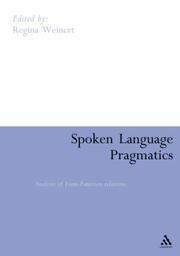
ISBN: 128320259X 9786613202598 1441109269 9781441109262 9780826493316 0826493319 6613202592 Year: 2007 Publisher: London Continuum
Abstract | Keywords | Export | Availability | Bookmark
 Loading...
Loading...Choose an application
- Reference Manager
- EndNote
- RefWorks (Direct export to RefWorks)
This volume provides a detailed analysis of the relationships between form and function in spontaneous spoken language. The contributors analyse English, German and Spanish data to present a multilingual perspective on the complexities facing speakers in a variety of contexts. Through an examination of the language of everyday conversation, interviews, consultations, task-based dialogues, football commentaries, radio-play productions and intercultural conversations, the book demonstrates the effect of informational, discourse-external and personal factors on form and shows how speakers positi
Colloquial language. --- Discourse analysis. --- Pragmatics. --- Pragmalinguistics --- General semantics --- Language and languages --- Logic, Symbolic and mathematical --- Semantics (Philosophy) --- Discourse grammar --- Text grammar --- Semantics --- Semiotics --- Colloquialisms --- Conversational language --- Speech --- Philosophy --- Pragmatics
Book
ISBN: 9783034300049 Year: 2009 Publisher: Bern : Lang,
Abstract | Keywords | Export | Availability | Bookmark
 Loading...
Loading...Choose an application
- Reference Manager
- EndNote
- RefWorks (Direct export to RefWorks)
#KVHA:Taalkunde; Spaans --- #KVHA:Columns; Spaans --- #KVHA:Journalistiek; Spaans --- Colloquial language. --- Newspapers --- Spanish language --- Spanish newspapers --- Language. --- Spoken Spanish. --- Written Spanish. --- Sections, columns, etc. --- Colloquial language --- Written Spanish --- Written communication --- Newspaper style --- Colloquialisms --- Conversational language --- Language and languages --- Speech --- Language --- Spoken Spanish --- Sections, columns, etc
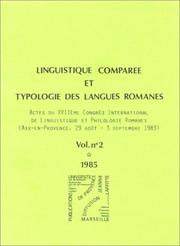
ISBN: 2853991040 2853991059 285399113X 2853991202 2853991288 2853991296 285399130X 2853991377 2853991385 9782853991056 9782853991209 9782853991049 Year: 1984 Publisher: Aix-en-Provence Université de Provence. Service des publications
Abstract | Keywords | Export | Availability | Bookmark
 Loading...
Loading...Choose an application
- Reference Manager
- EndNote
- RefWorks (Direct export to RefWorks)
-804 --- Romance languages --- Neo-Latin languages --- 804 Romaanse taalkunde --- Romaanse taalkunde --- Social aspects --- -Congresses --- 804 --- Italic languages and dialects --- Social aspects&delete& --- Congresses --- Congresses. --- Langues romanes --- Langues en contact --- Linguistique --- Discours --- Colloquial language --- Languages in contact --- Colloquialisms --- Conversational language --- Language and languages --- Speech --- Romance philology --- Sociolinguistique --- Linguistique comparée
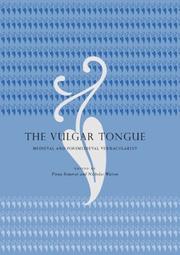
ISBN: 0271023104 Year: 2004 Publisher: University Park Pennsylvania State university press
Abstract | Keywords | Export | Availability | Bookmark
 Loading...
Loading...Choose an application
- Reference Manager
- EndNote
- RefWorks (Direct export to RefWorks)
Colloquial language --- Colloquial language. --- Colloquialisms --- Conversational language --- Language and languages --- Speech --- Europe --- Council of Europe countries --- Eastern Hemisphere --- Eurasia --- Languages --- History. --- History of Europe --- Sociolinguistics --- anno 1100-1199 --- anno 1500-1799 --- anno 1200-1499 --- Langue parlée --- Langues --- Histoire --- Langue parlée. --- Langue parlée
Book
ISSN: 13880373 ISBN: 9789027204974 9027204977 9027261539 Year: 2020 Volume: 94 Publisher: Amsterdam ; Philadelphia : John Benjamins Publishing Company,
Abstract | Keywords | Export | Availability | Bookmark
 Loading...
Loading...Choose an application
- Reference Manager
- EndNote
- RefWorks (Direct export to RefWorks)
"What is the best way to analyze spontaneous spoken language? In their search for the basic units of spoken language the authors of this volume opt for a corpus-driven approach. They share a strong conviction that prosodic structure is essential for the study of spoken discourse and each bring their own theoretical and practical experience to the table. In the first part of the book they segment spoken material from a range of different languages (Russian, Hebrew, Central Pomo (an indigenous language from California), French, Japanese, Italian, and Brazilian Portuguese). In the second part of the book each author analyzes the same two spoken English samples, but looking at them from different perspectives, using different methods of analysis as reflected in their respective analyses in Part I. This approach allows for common tendencies of segmentation to emerge, both prosodic and segmental".
Colloquial language. --- Corpora (Linguistics). --- Discourse analysis. --- Extemporaneous speaking. --- Grammar, Comparative and general --- Phonetics. --- Speech acts (Linguistics). --- Syntax. --- Colloquial language --- Extemporaneous speaking --- Speech acts (Linguistics) --- Phonetics --- Discourse analysis --- Corpora (Linguistics) --- Syntax --- Grammar, Comparative and general - Syntax --- Colloquialisms --- Conversational language --- Language and languages --- Speech
| Listing 1 - 10 of 13 | << page >> |
Sort by
|

 Search
Search Feedback
Feedback About UniCat
About UniCat  Help
Help News
News